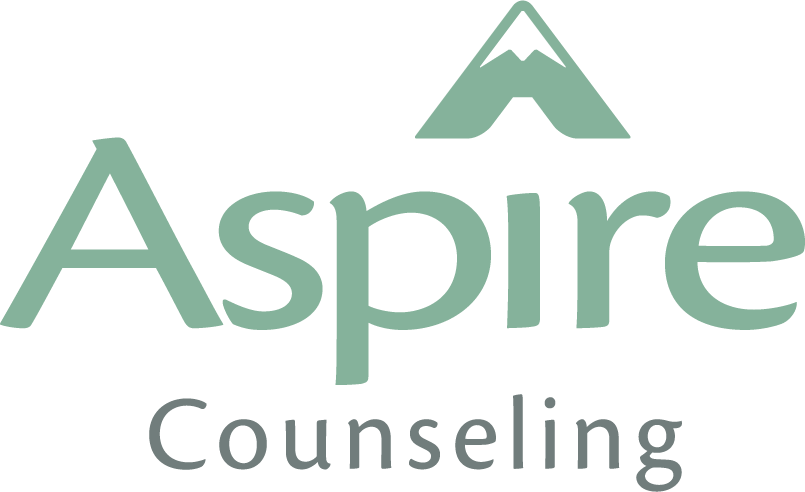Cognitive Behavioral Therapy: An Introduction to CBT
Cognitive behavioral therapy, or CBT, is a type of psychotherapy that has been shown to be effective in treating a variety of mental health conditions. CBT focuses on the relationship between thoughts, feelings and behaviors. It aims to change dysfunctional thoughts and behaviors in order to improve emotional well-being. In this blog post, we will discuss the basics of CBT, including what it is, how it works, some of its benefits, common ways we use CBT here at Aspire Counseling and answers to common questions about CBT.
What is Cognitive Behavioral Therapy?
Cognitive Behavioral Therapy, or CBT for short, is a specific kind of help that you can get when you’re feeling sad, worried, or having a tough time with your thoughts.
In CBT, you and your therapist work together as a team. You talk about the things that are bothering you, and your therapist helps you notice how your thoughts might be making you feel bad or act in ways you don’t like. Then, you learn how to change those thoughts into ones that help you feel better and do better.
CBT is based on evidence, which means it has been tested and proven to really work for a lot of people. It helps you handle tough times, with your therapist guiding you and supporting you all the way.
Cognitive Behavioral Therapy: The Basics
Photo by Paola Chaaya on Unsplash downloaded 4/19/22
CBT is considered to be an evidence-based approach to psychotherapy, which means that it has been shown to be effective in treating a variety of mental health conditions. The basis of CBT is the idea that thoughts, feelings and behaviors are interconnected, and that by changing your thoughts about a situation, you can change how you feel and /or react to things going on around you.
CBT typically involves working with a therapist to identify and change negative or distorted thinking patterns, as well as unhealthy behaviors. CBT can be used to treat conditions such as anxiety, depression, eating disorders, substance abuse and more. Some of the benefits of CBT include improved mental health, increased coping skills and improved quality of life.
How CBT Works
CBT generally focuses on the here-and-now, rather than on past events or future worries. The therapist and client work together to identify negative or distorted thinking patterns, as well as unhealthy behaviors. Once these are identified, the therapist works with the client to change these thoughts and behaviors.
CBT typically involves homework assignments, such as keeping a thought journal or practicing coping skills outside of therapy sessions. These assignments are meant to help clients generalize the skills they learn in therapy to their everyday life.
You Can Use CBT Even After You Finish Counseling
One of the great things about Cognitive Behavioral Therapy is that the skills you learn in therapy to deal with the mental health problem bringing you into counseling can be used long after you finish counseling.
For example, maybe you're coming into counseling because you're struggling in your interpersonal relationships. You learn to avoid some of the most common "thinking errors" or "sticky thoughts" and think about things in your life in a healthier manner. As a result, you feel less defensive and behave in such a way that your relationships improve. Therefore, you stop attending counseling. But months later you find yourself in a totally different stressful situation at work. You are again able to observe your thoughts, identify any thinking errors (maybe you reference some of your old CBT homework pages from your therapist), change how you think about the situation and feel better. In essence, CBT teaches you to be your own therapist.
Benefits of CBT
CBT has been shown to be an effective treatment for a variety of mental health conditions. Some of the benefits of CBT include improved mental health, increased coping skills and improved quality of life. In addition, CBT has been found to be effective in treating physical health conditions such as chronic pain, insomnia and headaches.
CBT is a Big Umbrella
CBT is a big umbrella and there are many different types of CBT. Most therapists can offer some version of traditional CBT looking at the relationship between thoughts, feelings & actions and help you track those or change your relationship with your thoughts. Some CBT therapists are more specialized. It's important that you find a therapist who is trained in using CBT to treat the specific type of mental health concern that's bringing you into therapy.
Types of CBT to Treat Trauma
Trauma treatment is a very specific type of counseling that I truly believe needs a specialist. While CBT on it's own is great, it can almost be harmful as a trauma treatment when it's not done in a trauma informed way.
That said, many of the trauma therapies that have been developed, researched and validated as amazing PTSD treatment options are versions of CBT that are being delivered in a trauma informed way.
Cognitive Processing Therapy
Cognitive Processing Therapy (CPT) is a type of CBT that has been found to be very effective in treating PTSD. CPT involves learning about how trauma affects thoughts, feelings and behaviors.
First, past experiences, personality traits, coping skills and initial reactions in the environment all impact how a person thinks about the traumatic experience they went through. And often, somewhat unhealthy thoughts about the trauma get "stuck" which can lead to PTSD. Also, trauma can change how a person thinks about the world around them. These too beliefs can have a negative impact on how a person interacts with the world around them.
Cognitive Processing Therapy is an evidence based trauma therapy that targets these unhelpful thoughts after a traumatic experience. Clients also learn skills to help them challenge and change negative or distorted thinking patterns.
Trauma-Focused Cognitive Behavioral Therapy (TF-CBT)
Trauma-Focused Cognitive Behavioral Therapy (TF-CBT) is the "gold standard" for treating PTSD in children, teens & young adults. It's a type of CBT that has been found to be very effective in treating PTSD. TF-CBT involves learning about how trauma affects thoughts, feelings and behaviors.
TF-CBT is a very structured trauma therapy, but it also gives a lot of flexibility to the therapist so they can apply the concepts in a way that works for that specific child, teen or young adult.
One of our clinicians, Kristi Sveum, is actually certified in TF-CBT and has helped many, many kids who have experience trauma through TF-CBT. It has all of the power of something like CPT for adults, includes lots of coping skills early on and still targets thoughts thoughts/feelings/behaviors that happen after trauma. But it truly is done in an age appropriate, child friendly way that is gentle enough to help even the youngest kiddos.
CBT for Anxiety Disorders
CBT is also commonly used to treat anxiety disorders. The goal of CBT for anxiety is to help you learn how to control and manage your anxiety. Often, people who suffer from anxiety have a hard time managing their worry and fear.
CBT can help you understand your thoughts and feelings about the things that make you anxious. It can also help you change the way you think and feel about your anxiety triggers. And finally, CBT can help you learn healthy coping skills to manage your anxiety.
Dialectical Behavior Therapy (DBT) as a Version of CBT
Dialectical Behavior Therapy (DBT) is considered a form of CBT. In fact, my student intern, Jasmine, is taking a CBT class right now as part of her graduate studies and was telling me how they covered DBT in class. However, I think of DBT as having a lot of unique components that really set is apart from most forms of CBT.
DBT was originally developed to treat people with borderline personality disorder (BPD). BPD is characterized by impulsivity, instability and a lot of intense emotions. That said, since Marsha Linehan's official book on DBT was originally released in 1993, numerous studies have shown that DBT can be an effective treatment for many, many mental health concerns including everything from substance abuse to eating disorders & beyond.
DBT targets these symptoms by helping people learn skills in four different areas: mindfulness, distress tolerance, emotion regulation and interpersonal effectiveness. Honestly, most of us use these skills to some degree. But DBT helps people be more purposeful in how they use them. It gives you a framework for handling difficult situations. And yes, there are a few really different skills taught in DBT that you probably never would learn otherwise.
While DBT does address a person's thoughts, and a "chain analysis" involves looking at a person's thoughts/feelings/behaviors in a given situation, there is also a very strong focus on changing behavior first with DBT. Teaching clients to use those skills we just mentioned. And through using these very specific skills, their thoughts and emotions then change. So...the same old CBT triangle just sometimes interrupting the cycle in a different way.
Frequently Asked Questions about CBT
Cognitive Behavioral Therapy, or CBT, is a helpful kind of therapy that works to change the way you think and act to help you feel better. Here are some common questions people ask about CBT, answered in a simple and clear way.
How Does CBT Work?
CBT works by helping you understand and change your thoughts, feelings, and actions. With your therapist, you'll talk about what's going on in your life and find patterns in your thoughts that might be making you feel bad or act in ways you don't like. Together, you’ll work on changing those thoughts and learning new behaviors. This process can help improve your mood and make life feel easier.
What Do Clients Do in Cognitive Behavioral Therapy?
In cognitive behavioral therapy, clients work closely with their therapists to talk about their challenges and learn new ways of thinking and acting. They practice skills during sessions and sometimes have homework to do in between. This homework might include keeping a journal or trying out new behaviors. It’s all about practicing the skills in real life to make lasting change.
What is the Role of a Cognitive Behavioural Therapist?
A cognitive behavioural therapist is like a coach. They help guide and support you through the process of CBT. They listen to what you have to say, help you understand your thoughts and feelings, and teach you new skills to manage challenges. They also help you set goals and celebrate your progress along the way.
What is an Example of Cognitive Behavioral Therapy?
All of the specific types of cognitive behavior therapy we discussed above (DBT, TF-CBT, CPT) are examples of CBT that we often use at Aspire Counseling. The truth is, there are many many examples of how a therapist might use CBT. For example, here’s a classic example of cognitive therapy: Let's say you're really scared of dogs and you start to avoid going to parks because you might see one. In CBT, your therapist might help you challenge and change your fearful thoughts about dogs and gradually face your fear in a safe and controlled way. Over time, this can help reduce your fear and make going to the park fun again.
What Are Some Cognitive Behavioral Therapy Techniques?
Some common cognitive behavioral therapy techniques include identifying and challenging negative thoughts, learning and practicing new behaviors, and developing problem-solving skills. Your therapist might also teach you relaxation techniques to help manage stress and anxiety.
What Techniques Are Used in Cognitive Behavioral Therapy?
There are many techniques used in CBT. These might include things like cognitive restructuring (changing negative thought patterns), exposure therapy (gradually facing and overcoming fears), and role-playing (practicing new behaviors in a safe setting). Your therapist will choose the techniques that are right for you.
What is a Typical CBT Session Plan?
A typical CBT session usually starts with a check-in on how you’re doing and a review of any homework from the last session. Next, you and your therapist will set goals for the current session. Most of the session is spent learning and practicing new skills. At the end, you might get homework and talk about what to work on next time. Remember, CBT is a partnership between you and your therapist, working together for positive change.
Whether you're looking for cognitive behavioral therapy for anxiety near me, cognitive behavioral therapy for anxiety and depression, or even pediatric cognitive behavioral therapy near me, CBT can be a powerful tool to help improve mental well-being and achieve your goals in therapy.
Can CBT Help with Anxiety and Depression?
Yes, CBT is a highly effective treatment for both anxiety and depression. It helps individuals identify and challenge negative thought patterns and behaviors, replacing them with more positive and balanced ones. If you're searching for "CBT for anxiety and depression near me," our therapists at Aspire Counseling are experienced and ready to help.
CBT at Aspire Counseling: Why Choose Us?
At Aspire Counseling in Missouri, we have a team of therapists skilled in Cognitive Behavioral Therapy. Whether you're at our Lee’s Summit or Columbia location, you can expect personalized and compassionate care. We are dedicated to helping you understand your thoughts, feelings, and behaviors, and equip you with tools for lasting change.
Our therapists specialize in various forms of CBT, ensuring that you receive the approach best suited to your needs. If you're searching for a “CBT therapist near me” in Missouri, look no further than Aspire Counseling. Contact us today to begin your journey towards a healthier, happier life.
Begin Cognitive Behavioral Therapy in Missouri
At Aspire Counseling, we are proud to offer CBT (including specific CBT based approaches such as Cognitive Processing, TF-CBT & DBT) to our clients. We believe in its power to help people overcome mental health challenges and live their best lives. If you are interested in learning more about CBT or any of the other services we offer, please contact us today.
Our therapists believe that you deserve counseling that truly works. You don't want to just come in each week and talk about your week. You want true change. Deep change. And then, you want to be able to move on with your life. That's what we want for you too, and that's why Aspire Counseling focuses so heavily on using evidence based counseling methods while always, always individualizing your treatment to fit you as a person.
We offer in person counseling near Blue Springs, MO at our Lee’s Summit counseling office or in Mid Missouri in our Columbia office as well as online throughout the state of Missouri. So, what are you waiting for? We’re here to support you.
If you reach out, our intake team will take the time to get to find out what you're looking for and to suggest a therapist that will be a good fit. Then, you'll have a free consultation. And if that counselor isn't a good fit? Our intake team will help you figure out who else to speak to. We know looking for a therapist is stressful. But it's important you find the right person who can truly help. We know that and our entire intake process is focused on that: finding the person with the skills, training, wisdom & personality to truly be a fit for your specific mental health needs.



